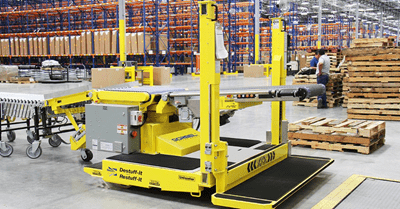Revolutionizing Loading Dock Efficiency: The Hidden Potential of Portable Conveyor Solutions

Portable ergonomic conveyor systems are transforming outdated loading dock operations by cutting unloading times in half and doubling case handling rates. With improved safety, flexibility, and rapid ROI, these solutions offer warehouses a powerful way to boost efficiency and reduce costs.
Picture this: it's Monday morning, and your dock supervisor approaches with yet another report of weekend overtime charges, detention fees, and a worker calling in with a back injury from trailer unloading. Sound familiar? If you're nodding, you're experiencing the pain points that plague countless warehouse operations across North America. While most facilities have optimized their internal material handling with sophisticated equipment, the loading dock remains surprisingly antiquated—a bottleneck where efficiency goes to die. Traditional trailer loading and unloading methods create a perfect storm of inefficiency. Workers armed with nothing more than work gloves and determination face floor-stacked cargo that can tower nearly to the trailer ceiling. The physical demands are staggering: constant bending, reaching, lifting, and twisting while maneuvering boxes weighing up to 50 pounds or more. This repetitive motion nightmare doesn't just threaten worker safety—it kills productivity. Consider the mathematics of manual unloading. A typical trailer might contain 800 to 1,200 individual cartons. Using conventional methods, two workers can process roughly 300-400 boxes per hour, meaning a single trailer can tie up dock space for three to four hours. During peak seasons or when facing driver detention fees, these delays compound into significant operational costs that many managers reluctantly accept as unavoidable. Enter portable ergonomic conveyor systems—technology that's quietly revolutionizing loading dock operations nationwide. These self-propelled units, exemplified by systems like the Destuff-it for unloading and Restuff-it for bidirectional operations, fundamentally reimagine how floor-loaded cargo moves through your facility. Unlike fixed automation that requires substantial infrastructure investment, portable conveyors offer immediate deployment flexibility. Picture a compact, battery-powered unit that workers can drive directly into a trailer. The system features an adjustable operator platform that elevates workers to optimal positions relative to the cargo wall, while a pivoting conveyor belt removes the need for lifting, carrying, or awkward positioning. The productivity gains are remarkable and measurable. Facilities implementing portable conveyor systems typically observe 50% reductions in unloading times. More impressively, case handling rates frequently exceed 800 boxes per hour—more than doubling traditional manual methods. This translates directly into reduced detention fees, lower labor costs, and increased dock door utilization. Safety improvements prove equally compelling. By eliminating the need for step stools and reducing repetitive lifting motions, these systems address primary injury causes in dock operations. Workers position themselves at ergonomically optimal heights while the conveyor handles the physical transfer, dramatically reducing musculoskeletal strain and associated workers' compensation claims. The benefits extend far beyond simple time savings. Enhanced cube utilization becomes achievable when workers can safely access trailer ceiling areas without compromising safety protocols. Operations report approaching 100% trailer space utilization, effectively reducing the number of required shipments and associated transportation costs. Integration capabilities further amplify value propositions. These portable systems seamlessly connect with existing dock conveyors, sortation equipment, and palletizing systems. The modularity means facilities can implement solutions incrementally, testing and proving concepts before broader deployment. Seasonal flexibility represents another strategic advantage. During peak periods, portable units can be rapidly deployed to high-volume areas. When volumes normalize, the same equipment relocates to support routine operations without stranded capital investment. Successful implementation begins with operational assessment. Calculate current unloading times, labor costs, and detention fees to establish baseline metrics. Most facilities discover that equipment investments pay for themselves within months through reduced labor requirements and eliminated overtime expenses. Power infrastructure typically requires minimal modification. Standard 480V/3Ph/60Hz electrical service supports most systems, though alternative power configurations accommodate varied facility requirements. The self-contained nature means no permanent dock modifications or complex installation procedures. Training requirements remain minimal. Operators familiar with basic material handling equipment adapt quickly to intuitive controls and safety systems. Built-in safety features, including area scanners, pressure-sensitive mats, and emergency stops, ensure safe operation even during intensive training periods. Forward-thinking warehouse managers recognize that loading dock optimization represents one of the final frontiers in operational efficiency. While internal material handling has evolved dramatically, dock operations often remain surprisingly manual and inefficient. The question isn't whether portable conveyor technology can improve your operation: extensive case studies demonstrate consistent benefits across diverse applications. The question becomes how quickly you can implement these solutions to capture competitive advantages while addressing growing labor challenges and safety concerns. The path forward doesn't require complex analysis or lengthy evaluation periods. Raymond West's material handling specialists understand the unique challenges facing warehouse operations and can assess your specific dock configuration to identify optimization opportunities. Their expertise in portable conveyor solutions, combined with comprehensive service capabilities, ensures implementations that deliver measurable results from day one. Contact Raymond West today at (562) 944-8067 to schedule a dock optimization consultation and discover how portable conveyor solutions can transform your operation's efficiency, safety, and bottom line.The Loading Dock Dilemma: More Complex Than It Appears
The Ergonomic Revolution: Portable Conveyor Systems Transform Operations
Quantifying the Impact: Numbers That Reshape ROI Calculations
Beyond Basic Unloading: Strategic Operational Advantages
Implementation Considerations: Practical Steps Forward
Strategic Implementation: Moving Beyond Status Quo
Your Next Step Toward Dock Optimization

